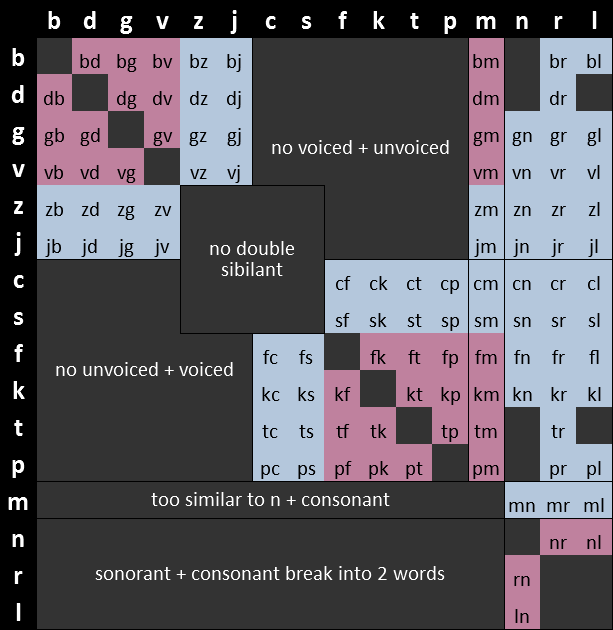Understanding a language’s morphology helps us to:
- Recognise its words.
- Identify their type.
- Create our own words.
🪶 Jargon: Morphology
In linguistics, morphology is the study of words and how they are constructed.
If we compare it to cooking, a language’s morphology contains the recipes to make different types of words.
In this chapter, we’ll focus on the ingredients of Eberban’s morphology which we’ll call “morphology features”.
A self-segregating morphology
Eberban’s morphology is designed to be self-segregating. That means we can unambiguously parse each word and identify their word boundaries just by reading/hearing the letters themselves.
This is true for all word types except quotation particles, which we’ll get to in a later chapter.
Symbols
When we get to the Word Types chapter, we’ll teach you each of their structures. This will come in two representations: English instructions and a symbolic representation.
Similar to a maths equation, the symbolic representation sums up the instructions tersely so that they’re easier to discuss and remember.
Now let’s go over the symbols that are completely foreign.
Vhowels
🪶 Jargon: Vhowels
When talking about the structure of each word type, “h” is always mentioned whenever vowels are. And “h” is only ever seen between vowels.
Let’s coin the term “vhowel” (pronounced “vee-howl”) to be a member of the set {h,i,e,a,o,u}. Note that if there is only one vhowel, then it cannot be “h”, as “h” must be between vowels.
Symbol: V̌
Sonorants
Sonorants never begin a word. They can be found in consonant pairs, consonant triplets, between vhowels, or at the end of a word.
Symbol: Ç
Consonant pairs
🪶 Jargon: Consonant pairs
Eberban has categorised consonant pairs into two types: initial and medial. Initial pairs are almost only found at the beginning of a word, whereas medial pairs must always be between vhowels.

Legend:
- Initial pairs
- Medial pairs
- Invalid pairs
Initial pair symbol: (CC)i
Medial pair symbol: (CC)m
Consonant triplets
🪶 Jargon: Consonant triplets
A consonant triplet is three consonants ABC such that:
- A is NOT a sonorant
- AB is a medial pair
- BC is an initial pair
Just like the medial pairs and the letter h, they must be between vowels.
✍️ Examples:
- kfr
- dvn
- gbj
Symbol: (ꞒCmCi)
Glues
🪶 Jargon: Glues
A glue is three consonants ABC such that:
- A is a sonorant
- BC is an initial pair
Called “glue” because the order of sonorant then initial pair doesn’t normally stick together.
✍️ Examples:
- njb
- rsk
- lfr
Symbol: (ÇCCi)
Table of symbols
Here are all of the symbols. You’ll see them again in the Word Types chapter as a dropdown.
| Symbol | Meaning |
|---|---|
C | Consonant |
Ç | Sonorant |
Ꞓ | Non-sonorant consonant |
() | Group |
(CC)i | Initial pair |
(CC)m | Medial pair |
(ꞒCmCi) | Consonant triplet |
(ÇCCi) | Glue |
Cany | Any of: consonant, initial pair, medial pair, consonant triplet, glue |
u | The letter u |
i | The letter i |
V | Vowel |
(V-i) | Any vowel except the letter i |
(V-u) | Any vowel except the letter u |
V̌ | Vhowel |
B | Boundary: either space or ' |
| | Or |
? | 0 or 1 of the preceding |
* | 0 or more of the preceding |
+ | 1 or more of the preceding |